Distinguishing Moissanite from Diamond: A Comprehensive Guide
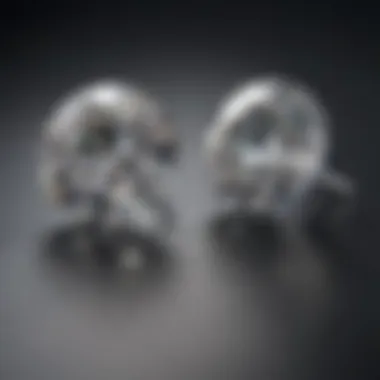
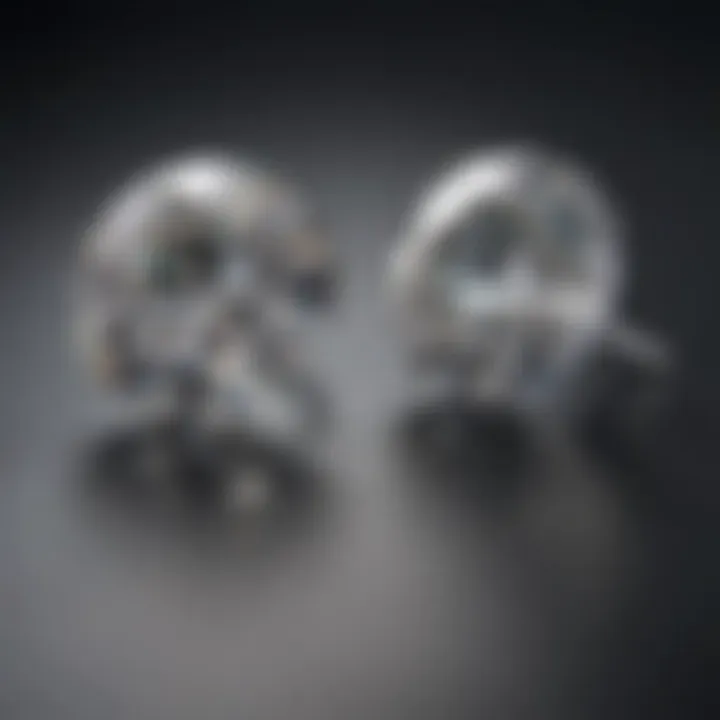
Intro
When it comes to gemstones, the conversation often bubbles to the top with a few heavyweights, particularly diamonds and moissanite. Each holds a special place in the jewelers’ toolkit, not just for their brilliant aesthetics but also for the multitude of meanings that surround them. However, distinguishing between these two remarkable stones is akin to peeling an onion; there are layers upon layers of information waiting to be uncovered. This guide aims to shed light on the intricate differences, helping readers navigate the rocky terrain of gemstone choice, whether they’re in the market for an engagement ring or just looking to expand their collection.
Understanding the nuances between diamonds and moissanite goes beyond mere preference; it can significantly impact both value and appeal. As consumers become more educated about options available, the need for clarity in distinguishing these gemstones becomes paramount. Let’s dive in to explore definitions, historical significance, and unique characteristics that set these two apart.
Preamble
In the world of gemstones, the distinction between moissanite and diamonds is not just a matter of aesthetics; it encompasses a web of scientific intricacies, market dynamics, and personal choices. With increasing consumer awareness and evolving trends, it's vital to not only appreciate their beauty but also to understand the nuances that set them apart. This article provides a thorough exploration into these two remarkable stones, offering gems enthusiasts, jewelers, and potential buyers a profound understanding of their unique qualities.
As we navigate through this guide, we will delve into the historical, chemical, physical, and optical differences between moissanite and diamonds. Knowing these specifics can aid buyers in making educated purchases, particularly in a marketplace swamped with options.
Furthermore, both stones hold significant cultural and emotional value. Recognizing this emotional investment involved when selecting a gemstone can be just as important as knowing about its composition or market value. Therefore, equipping oneself with knowledge on what truly differentiates moissanite from diamonds can lead to more satisfying choices.
Understanding Gemstones
Gemstones have fabled allure and charm, often representing love, status, or personal milestones. They’re not merely ornamental but hold stories that date back millennia. Various cultures have ascribed different meanings to gemstones, elevating them into symbols of wealth or power. Different stones emerge from distinct geological processes, each contributing to the story of how they formed and what they represent.
When we talk about gemstones, it's essential to consider the Four Cs: Carat, Cut, Clarity, and Color. These characteristics define both the aesthetic appeal and the commercial value of the stone. However, beyond surface-level attributes, understanding the origins and compositions of these precious materials is fundamental. Every gemstone tells a narrative, from where it was mined to the techniques used in crafting it into a piece of jewelry. This section lays the groundwork for comprehending what makes moissanite and diamonds more than just shiny rocks.
Overview of Moissanite and Diamond
Moissanite and diamonds, though often compared, are fundamentally different. Diamonds are formed deep within the Earth under extreme heat and pressure over billions of years, making each stone unique with a geological fingerprint. Their remarkable strength, rated 10 on Mohs hardness scale, coupled with their sparkle, has made them the traditional choice for engagement rings and heirlooms.
On the other hand, moissanite, originally discovered in meteorites, has gained popularity as a diamond alternative. Its creation is no accident; modern advancements allow for the lab creation of moissanite, presenting a cost-effective yet aesthetically pleasing option for consumers. Its hardness, though somewhat lower at 9.25 on the Mohs scale, still exceeds that of most gemstones, affirming its durability.
Although moissanite's price tag is substantially less than that of diamonds, its optical properties might just steal the show. Many have noted that moissanite exhibits a fire and brilliance that sometimes surpasses that of diamonds, resulting in a captivating sparkle that can lead to confusion. This section sets the stage for a deeper investigation into how to distinguish among these two stones in terms of their appealing visual traits and physical durability.
Historical Context
Understanding the historical context of moissanite and diamond is crucial for gem enthusiasts and collectors alike. This exploration sheds light on the paths these gemstones have taken—from their initial discoveries to their roles in society—highlighting not just the gems themselves, but also the human narratives threaded through them. Grasping this background can influence modern perceptions and elevate appreciation for these stones, enhancing the decision-making process for potential buyers.
The Discovery of Moissanite
Moissanite's story begins in 1893, when Henri Moissan discovered it within a meteorite, the Canyon Diablo meteorite, found in Arizona. Initially, he thought he had uncovered diamonds, a discovery that would have made quite a splash in the gem world. The gem’s unexpected origin, birthed from cosmic events, makes it unique. That otherworldly background has led some to regard moissanite as a symbol of beauty that travels through time and space, far removed from Earth’s geological processes.
For many years, moissanite remained something of a curiosity, absent from the jewelry scene. It wasn’t until the 1990s that it began gaining traction as a diamond alternative. Advances in technology allowed for the synthesis of moissanite, making it more widely available and providing a more affordable option in the luxury jewelry market. This journey from a celestial phenomenon to an accessible gem underscores the adaptability and continual evolution of gemstones in response to consumer desires and technological advancements. Notably, the introduction of lab-created moissanite also raised questions about its identity and authenticity compared to natural gems.
The Evolution of Diamonds in Society
Diamonds have a much longer and more storied history. Dating back thousands of years, diamonds were initially utilized in India, where they were valued for their hardness and beauty. Fast forward to the 20th century, and diamonds cemented themselves as the go-to stone for engagement rings, heavily influenced by marketing campaigns, most famously by De Beers with their catchphrase, "A diamond is forever."
This cultural evolution played a significant role in establishing diamonds as the hallmark of love and commitment. They became symbols of status, power, and wealth, often worn by royals and celebrities. Their value was not just in their physical properties but also in what they represented—a promise, a memory, a status symbol.
The late 20th century saw the rise of ethical considerations surrounding diamond mining, leading to the advent of certifications like the Kimberley Process, aimed at reducing conflict diamonds. This shift in narrative not only shaped public perception, but also opened up alternatives like moissanite, which presented itself as a guilt-free option for discerning consumers.
With these insights into moissanite and diamond’s histories, it’s clear how the past shapes their current standing in the market. This context is essential for making informed choices today, whether one is purchasing a piece of jewelry or simply expanding their gemstone knowledge.
Chemical Composition
Understanding the chemical composition of moissanite and diamonds is pivotal for distinguishing these two captivating gemstones. Their distinct structures and elemental make-ups not only determine their visual characteristics but also heavily influence their performance and longevity as jewelry. The science behind what these stones are made of underpins the rest of our discussion, making it a critical aspect for gemstone enthusiasts and collectors alike.
Elements and Formulae
Moissanite is primarily composed of silicon carbide, represented by the chemical formula SiC. This compound combines silicon and carbon in a crystal lattice arrangement, contributing to its unique optical properties. On the other hand, diamonds consist purely of carbon, structured in a crystalline form known as diamond cubic. The straightforward formula for diamond is C.
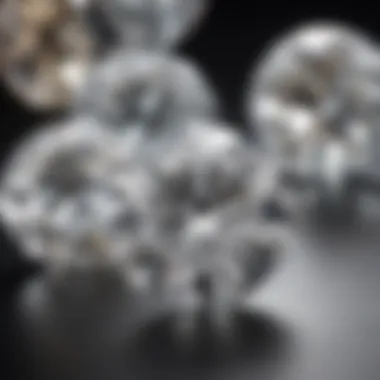
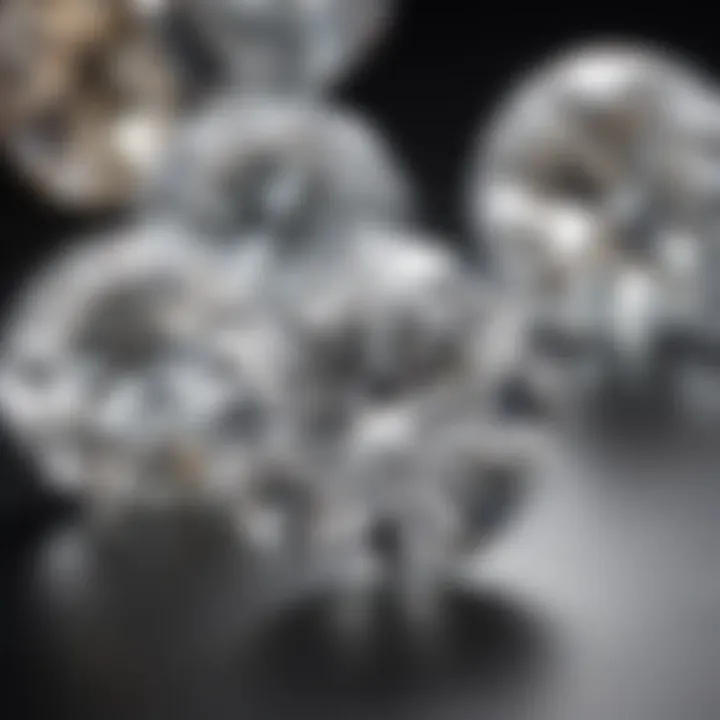
Both gemstones differ significantly at the molecular level. The presence of silicon in moissanite provides it with specific traits, such as its notable hardness and ability to bend light. In fact, the arrangement of atoms within each gemstone leads to different spectacular visual effects. For example, while diamonds showcase their brilliance, moissanite’s sparkle often exhibits more fire, a term that describes the spectrum of colors emitted as light hits the stone.
"The elements of a gemstone dictate not just its looks but how it behaves in various environments. Understanding these substances is a first step in making informed choices."
Stability and Durability
When it comes to stability, both moissanite and diamonds hold their own, but they exhibit variation in terms of durability and practical lifespan. Diamonds score the highest on the Mohs scale of hardness, rated at 10. This means they are incredibly resistant to scratches and damage, making them a favored choice for everyday wear, such as engagement rings.
Moissanite, while slightly softer with a rating of around 9.25, still boasts exceptional durability and is suitable for long-term wear. The resilience of both gemstones encapsulates their suitability for various types of jewelry. While diamonds might be renowned for their legendary status and preservative qualities, moissanite’s stability under heat and aggressive chemicals should not be underestimated.
Physical Properties
Understanding the physical properties of gemstones is crucial, particularly when distinguishing between moissanite and diamonds. These properties not only enhance our appreciation of the stones, but they also provide insights into their durability, visual appeal, and suitability for various applications, especially in jewelry. When selecting a gemstone, knowing its physical attributes—such as hardness, toughness, and the refractive index—can make all the difference in terms of performance and visual delight.
Moissanite and diamonds, while both stunning, present different advantages regarding wearability and brilliance. The unique characteristics of each gemstone influence consumer choices, maintenance, and long-term value retention. Hence, acknowledging these properties offers a robust foundation for anyone looking to make informed decisions in the jewelry marketplace.
Hardness and Toughness
When it comes to hardness, diamonds take the crown. Ranking at a perfect 10 on the Mohs scale, diamonds are renowned for their incredible resistance to scratches. Moissanite, however, is no wallflower; it ranks between 9.25 and 9.5, making it very resilient, though slightly less so than diamonds. This difference in hardness plays a significant role in how each gemstone is suited for everyday wear.
In practical terms, the implications of hardness are profound. A diamond engagement ring can withstand years of daily wear and tear without significant signs of scratching, while a moissanite ring, being a bit softer, might show wear over time but remains suitable for regular use.
Toughness, which refers to a gemstone's ability to resist breaking and chipping, varies between these two as well. Diamonds are not only hard but also quite brittle, meaning they can chip if struck with enough force. Moissanite, on the other hand, is more flexible. It can absorb shocks better, making it less prone to chipping. For instance, if one happens to drop a ring, the moissanite might come through unscathed while the diamond risks a hairline crack.
"The hardness of a gemstone often overshadows other critical attributes, but toughness frequently becomes the unsung hero when it comes to longevity."
Refractive Index Differences
The refractive index of a gemstone describes how light bends as it enters. This factor is responsible for creating the sparkle that so many people adore. Diamonds have a refractive index ranging from 2.42 to 2.44, which contributes to their brilliant shine. In contrast, moissanite possesses a higher refractive index, lying between 2.65 and 2.69, allowing it to reflect light even more dramatically.
This higher refractive index means that moissanite can exhibit a dazzling brilliance that some say outshines diamonds. The optical effects produced by moissanite tend to create a rainbow-like scattering of light, or what is called "fire" in gemology. Consumers might notice this attribute particularly in sunlit settings, as the light interacts with the stone's facets in exciting ways.
Despite the brilliance of moissanite, diamonds deliver a different facet of beauty through their more subtle and refined luster. The visual difference is more about preference than quality; some folks are drawn to the striking colors of moissanite, while others favor the classic elegance of diamonds.
Optical Properties
Optical properties play a significant role when examining gemstones. For moissanite and diamond, these properties can make or break their appeal in the eyes of consumers. Both stones boast extraordinary visual qualities, but a closer look reveals unique characteristics that differentiate them. Understanding these optical aspects not only enhances one's appreciation but also equips buyers with the knowledge to make informed decisions in the marketplace.
Brilliance and Fire
When discussing brilliance and fire, it's essential to grasp what these terms actually mean in the context of gemstones. Brilliance refers to how much white light a gemstone reflects, while fire describes the rainbow colors emitted when light disperses through the stone.
- Moissanite has a higher refractive index than diamond, which means it can reflect more light. This quality gives moissanite an intense brilliance that some people find more striking.
- Fire in moissanite is also remarkable; the stone tends to exhibit wider flashes of color compared to diamond. This vibrancy can be dazzling under certain lighting conditions.
By contrast, diamonds are often celebrated for their classic beauty. The refractive index of diamonds, while lower compared to moissanite, allows for a more subtle, yet sophisticated brilliance. The play of fire in diamonds is usually more muted, creating a serene visual impression rather than the explosive color of moissanite.
"The higher the refractive index, the more dazzling the gemstone. Moissanite generally takes the crown in this category."
Light Performance and Sparkle
The way light interacts with these stones contributes to their overall sparkle. Here, the architecture of each gemstone becomes crucial. A well-cut moissanite tends to catch light in a way that creates a striking, almost scintillating sparkle.
- In terms of light performance, moissanite can exude a vibrant dance of light and color, making it seem alive in diverse lighting conditions. This play of light might be seen as overly flashy to some.
- Diamond's sparkle, on the other hand, is often described as having a more refined appearance. The manner in which light travels through a diamond, coupled with its ideal cut, results in a refined yet powerful sparkle that many generations have cherished.
In summary, while both gemstones possess exceptional optical properties, the sparkle produced by each showcases different aesthetic approaches. Some buyers prefer the fiery, vibrant display of moissanite, while others may favor the understated elegance embodied in a well-cut diamond. These preferences are deeply personal and tend to fluctuate based on individual taste, making the optical properties a critical factor in choosing between these two captivating stones.
Identifying Features
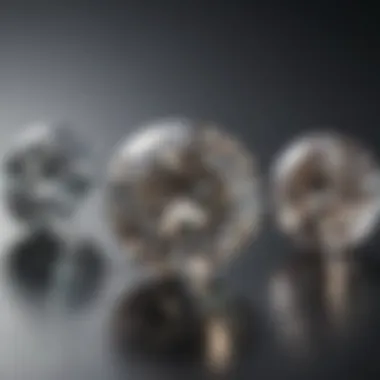
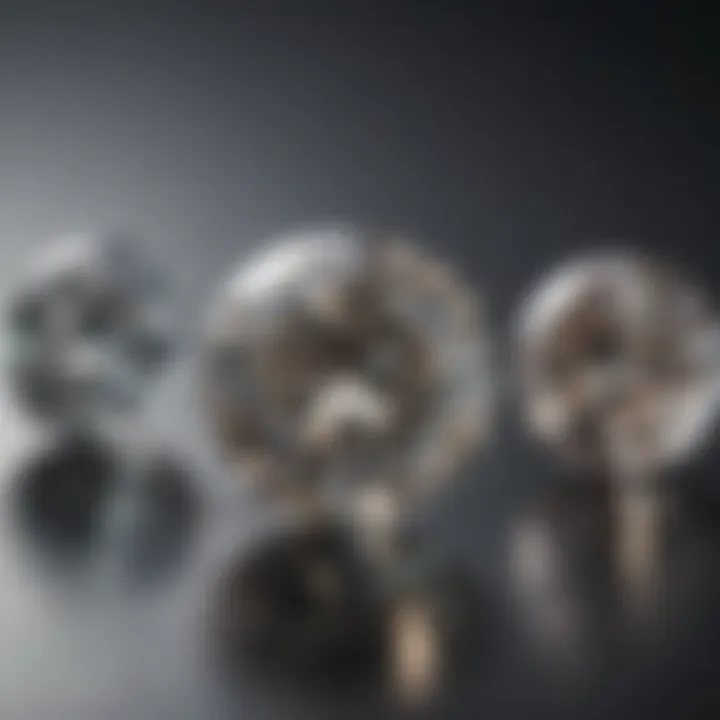
The ability to tell apart moissanite from diamond is not just about aesthetics but also influences purchasing decisions and personal satisfaction. For enthusiasts, collectors, and jewelers, understanding these identifying features is crucial. While both gems may dazzle and capture attention, each carries its own set of characteristics. Recognizing these traits can significantly enhance one's gemstone selection experience, ensuring that what you purchase aligns with your values, expectations, and budget.
Visual Inspection Techniques
Visual inspection is a fundamental step in distinguishing between moissanite and diamonds. Jewelers and collectors often rely on their sight to identify these stones, and it turns out that a keen eye can spot differences—if one knows what to look for. Here are some key aspects to observe during a visual inspection:
- Color Hues: Generally, diamonds range from colorless to shades of yellow or brown. Moissanite, however, may show more colorful hues, especially under certain lighting conditions. Even the faintest tinge can be a telltale sign.
- Sparkle Pattern: When juggling these two gemstones in front of bright light, observe the sparkle they emit. Moissanite tends to exhibit a unique play of color known as "fire." This effect results in a vivid display of rainbow flashes, while diamonds produce a more subdued sparkle, often described as crisp and bright.
- Inclusions: With close examination, one might spot inclusions within the stones. Diamonds often contain identifiable characteristics, such as tiny blemishes or clouds. Moissanites, being lab-created or found in nature differently, might show black inclusions, which can stand out.
- Table Size: Diamonds typically have proportioned tables that align with standard cut to ensure brilliance. Moissanite stones may sometimes have larger table sizes, producing a different geometric aesthetic and shine.
The visual inspection is both an art and a precision exercise, helping connoisseurs and buyers make informed decisions.
Use of Gemological Tools
In the realm of gems, the use of advanced gemological tools adds another layer of certainty in distinguishing moissanite from diamonds. Tools provide objectivity and precision that the naked eye might miss. Here are some gemological tools often utilized:
- Refractometer: This handheld device measures the refractive index of the gemstone. Diamonds typically have a refractive index of about 2.42, whereas moissanite falls between 2.65 and 2.69. A bit of reading with the refractometer can set things straight.
- Magnifying Loupe: A 10x magnifying loupe helps observe internal features of both stones. This tool is often used by jewelers to inspect for inclusions, clarity, and even the cut quality.
- Diffraction Grating: This tool helps analyze the spectrum of light that passes through the stone. A diamond will show a single, bright line when light passes through, while moissanite may present a more complex array of lines.
- Gem Tester: Some testers can identify materials based on their electrical conductivity and other properties. These devices help quickly ascertain the material without damaging the stone.
Using gemological tools guarantees accuracy in identification, fostering greater confidence in the gemstone market for both sellers and buyers.
In the world of gemstones, precision is paramount, and the right tools can keep one from falling for mere facades.
By marrying visual techniques with professional tools, one ensures a robust approach to differentiating moissanite from diamond.
Market Comparison
Understanding the market comparison between moissanite and diamonds is crucial for consumers and collectors alike. This section sheds light on the distinctive attributes and financial implications that influence buying decisions in the jewelry market. It's essential to grasp not only the aesthetic factors but also the economic aspects that can affect ownership, trade, and resale values of these gemstones.
Price Differences and Value Retention
When we look at price differences between moissanite and diamonds, the contrast is striking. Moissanite, being a lab-created gem, is generally more affordable compared to natural diamonds. One can find high-quality moissanite for a fraction of the price of a diamond of similar size and quality. This affordability opens doors for many buyers who might not have considered purchasing a diamond. That said, price is just one piece of the puzzle.
Considerations regarding value retention:
- Natural Diamond: Historically, diamonds have maintained a strong position in the resale market, with value often appreciated over time. This is largely due to their rarity and established demand across diverse cultures and societies.
- Moissanite: While it does offer excellent quality and brilliance, the resale value of moissanite can be quite low. As it’s more readily available, some buyers might find they lose a part of their initial investment when trying to resell.
Ultimately, it boils down to what you're looking for. If it's long-term investment and value retention, diamonds have the edge, whereas moissanite allows more flexibility in choice and style without breaking the bank.
Current Trends in Gem Consumption
Gem consumption trends are shifting, with more consumers leaning towards ethical considerations and personal performance. Moissanite is often viewed as a more ethical choice compared to diamonds. As some buyers are growing more conscious of sourcing practices, includes:
- Ethical Concern: The quest for ethically sourced gemstones is at the forefront today. Many consumers prefer lab-created gems like moissanite, which do not present the same ethical dilemmas as some natural diamonds.
- Impact of Social Media: Platforms like Facebook and Reddit have enabled discussions around moissanite and diamonds, amplifying awareness about their differences. Engaging content highlights the benefits of moissanite, influencing the purchasing decisions of younger, conscious consumers.
- Unique Designs: As customization takes center stage, moissanite allows for a broader variety of custom designs, appealing to those wanting something distinct.
In a nutshell, while traditional diamond sales continue, we see a marked growth in the acceptance of moissanite, driven by its ethical and economic advantages.
Ethical Considerations
The conversation surrounding gemstones, particularly diamonds and moissanite, extends well beyond their aesthetic appeal and financial implications. It probes deeper into our responsibility as consumers and the ethical landscapes of jewelry sourcing. Understanding how these precious stones are obtained and the implications of their supply chains is crucial in today's conscious consumerism era. This segment aims to emphasize the ethical considerations surrounding both diamonds and moissanites, shedding light on sourcing methods, environmental concerns, and the impact of choices made by consumers.
Sourcing of Diamonds vs. Moissanite
When it comes to sourcing, diamonds have long been associated with a stark reality: their allure often comes cloaked in ethical shadows. Many diamonds, particularly those labeled as blood diamonds, originate from conflict zones, funding violence and human rights abuses. The Kimberley Process Certification Scheme was established to address this issue, but its effectiveness has been debated. This regulatory effort aims to prevent the sale of conflict diamonds but has its weaknesses.
In stark contrast, moissanite offers an ethical alternative. Most moissanite available in the market is lab-created. This means they are cultivated in controlled environments with ethical labor practices. No land is ravaged, no workers exploited. For someone looking to make a thoughtful choice, opting for moissanite virtually eliminates many ethical concerns connected to gemstone sourcing.
"In a world where the choices consumers make can have significant societal impacts, understanding where a product comes from is pivotal."
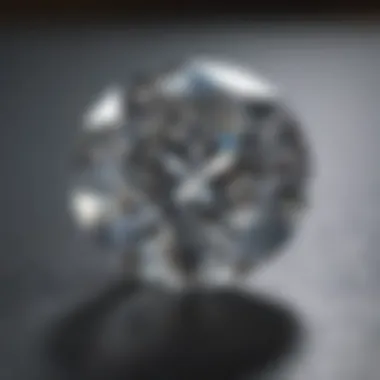
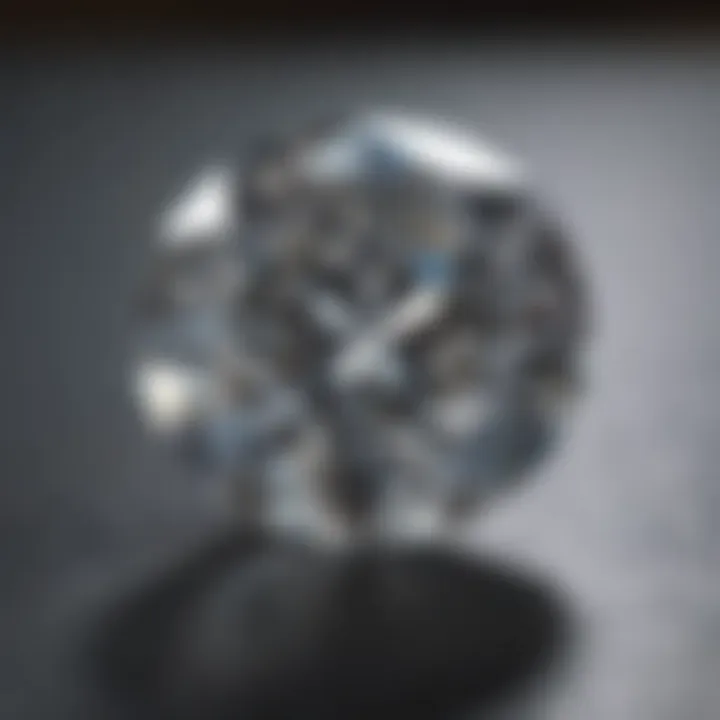
More specifically, some points to consider include:
- Environmental Impact:
- Human Rights:
- Community Development:
- Diamond mining can devastate ecosystems and contribute to soil and water pollution. In contrast, the manufacturing of moissanite has a significantly lower environmental footprint.
- Many diamond mines are plagued with reports of labor abuses. Conversely, reputable companies that produce moissanite ensure ethical labor standards are upheld.
- While diamond mining can bring opportunities to communities, it often leads to long-term damage. Moissanite production rarely involves such contentious practices.
Lab-Created Versus Natural Gems
The distinction between lab-created gemstones and their natural counterparts raises a platform of ethical discussion. On one hand, natural diamonds are limited resources, often saying they are unique due to their geological origin. On the flip side, lab-created gemstones like moissanite are engineered to possess similar physical properties but without the ethical baggage.
While there are traditionalists who insist on the superiority of natural stones, most of the consumer base is moving towards a more eco-conscious mindset. Lab-created gems have become more acceptable due to their affordability and the ethical assurances they provide. Here are several points to consider:
- Quality and Value: Lab-created moissanite gems often boast superior clarity and brilliance, not to mention a price tag that is easier on the wallet.
- Perception in Society: There is still a social stigma attached to lab-created stones, but perceptions are slowly shifting as more people educate themselves about the ethical implications of their choices.
- Investment Perspective: Natural gemstones like diamonds have traditionally been seen as investments. However, the market for lab-created stones is gaining traction as consumers become increasingly aware of ethical and environmental issues.
Consumer Preferences
Understanding consumer preferences in the context of moissanite and diamonds is crucial—not just for buyers deliberating their choices, but also for jewelers and marketers aiming to address customer needs effectively.
Consumer behavior is shaped by a myriad of factors. The decision to opt for one gemstone over the other is often influenced by emotional, ethical, and economic considerations. When people think about purchasing jewelry, it's not merely about the product itself; it's about the story behind it, its symbolism, and what it conveys about the wearer.
Factors Influencing Purchase Decisions
Many elements come into play when a customer decides between moissanite and diamonds. Here are some key factors that often influence this critical decision:
- Price Sensitivity: The cost of diamonds typically far exceeds that of moissanite. Many buyers seek value for their money.
- Ethical Concerns: An increasing number of consumers are worried about the ethical implications of mining diamonds, especially those tied to conflict regions. Moissanite, often lab-created, presents an appealing alternative.
- Aesthetic Preferences: While both stones are beautiful, they exhibit different visual characteristics, such as brilliance and fire. Individual taste plays a significant role here.
- Brand Perception: Some buyers are swayed by brand names that signify luxury or uniqueness. Well-known diamond brands can create a lasting impression, while moissanite may still be establishing that kind of brand identity.
- Longevity and Value: People often think about the long-term aspects. There is a common belief that diamonds hold their value better or are more timeless in comparison to moissanite.
When looking for jewelry, consumers are typically not just purchasing a product; they are investing in a memory or a milestone, perhaps an engagement or anniversary. Understanding these factors allows retailers to cater their offerings to meet potential buyers' specific desires and trepidations.
Perceptions and Misconceptions
While awareness about moissanite is rising, several misconceptions linger. These thoughts often cloud a consumer's judgment when choosing between these two gemstones. Here are some prevalent ideas:
- Moissanite vs. Diamond Quality: There’s a pervasive notion that moissanite is inferior simply because it’s created in a lab. However, many experts suggest that while moissanite can outperform diamonds in brilliance, it lacks the same cultural prestige.
- Longevity Issues: Some people might believe that moissanite won’t last as long as diamonds. In reality, moissanite is nearly as hard as diamonds, rated at 9.25 on the Mohs scale, making them quite durable.
- Cultural Significance: Diamonds have a long-standing cultural and emotional significance associated with various life events. On the contrary, moissanite might be seen as merely a trendy alternative without that deeper meaning.
- Value Retention: There's an assumption that diamonds are a better investment than moissanite. This is case-specific; while diamonds have a history of value retention, the market position of moissanite is evolving, and its acceptance is gaining traction.
The key takeaway here is the importance of education. Misunderstandings often arise from a lack of accurate information. By prompting discussions and debunking myths through knowledgeable interactions, consumers can make better-informed decisions, ultimately feeling more satisfied with their chosen gemstone.
"Consumer preferences are not merely a reflection of choice; they are influenced deeply by societal norms, knowledge, and the narrative surrounding the products they consider."
Navigating the world of gemstones is about more than just aesthetics. It involves understanding shifts in consumer sentiment that reflect broader changes in values and priorities. Through acknowledging these preferences, jewelers can build trust and foster relationships with their customers.
End
This article has journeyed through the intricate world of moissanite and diamonds, peeling back layers to reveal their unique characteristics. Understanding the distinction between these two gemstones is critical for both consumers and industry professionals alike. It's not just about aesthetics; there's a whole spectrum of elements to consider when making a purchase or examining these stones.
Recap of Key Differences
In summary, here are a few key differences worth revisiting:
- Chemical Composition: Diamonds are primarily made of carbon, while moissanite is composed of silicon carbide. This basic difference lays the foundation for many other comparisons.
- Hardness: Diamonds, rated a 10 on the Mohs scale, are the hardest known natural material, offering maximum durability. Moissanite, while impressive at 9.25, is still subject to wear and tear over time.
- Refractive Index: Moissanite boasts a higher refractive index than diamond—meaning it can exhibit more brilliance and fire under light. Yet, this can also lead to a different type of visual appeal that might not align with everyone’s preference.
- Price Point: On the financial side, moissanite typically comes at a fraction of the cost of diamonds, making it an alluring option for budget-conscious buyers.
"Understanding these differences allows consumers to make informed choices, ensuring their gemstone truly reflects their values and desires."
Final Thoughts on Choice and Value
As you weigh your options between moissanite and diamonds, consider not just the obvious financial implications but also the deeper values that guide your decision. For instance, if you prioritize sustainability, moissanite often presents a more environmentally friendly choice. On the flip side, if the cultural significance and glamour of a diamond resonate more with you, that too is a valid consideration.
Additionally, the perception of long-term value can differ. Diamonds have traditionally held their worth well, partly due to established market practices and emotional connections. Conversely, moissanite, with its becoming popularity, could become a valuable gem in its own right, especially as preferences shift in today's jewelry landscape.
In the end, both moissanite and diamonds have their merits. Your choice should harmonize with your personal style, your budget, and your values. Armed with this knowledge, you are better equipped to navigate the jewel market, making decisions that reflect not just the glamour of the stones, but also the integrity of your choices.







